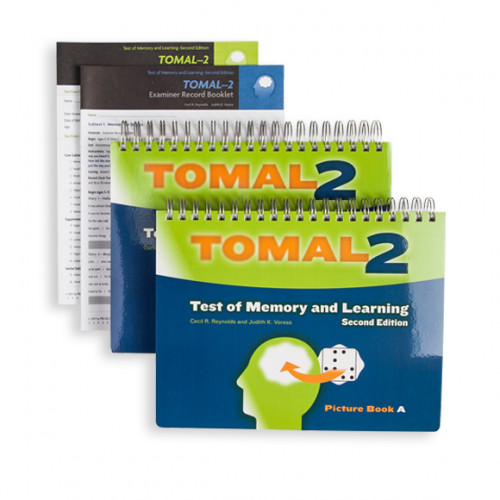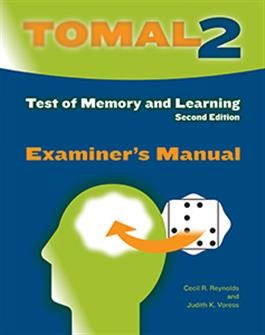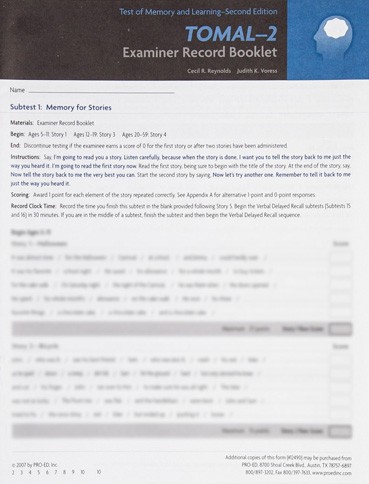New in Test of Memory and Learning (TOMAL-2):
- Reduced administration time
- Additional analyses of cultural impact to ensure culturally fair assessment of memory
- Improved clarity of scoring and administration rules
- Now normed for children and adults, ages 5 years through 59-11
- Reformulated core subtests and core indexes
- Redesigned, convenient to use Record Booklet
- New Verbal Delayed Recall Index
- Additional interpretive tables and text
The TOMAL-2 includes 8 core subtests, 6 supplementary subtests, and 2 delayed recall tasks that evaluate general and specific memory functions; features composite memory scores for Verbal Memory, Nonverbal Memory, and a Composite Memory Index; has supplementary composite scores that include a Verbal Delayed Recall Index, Learning Index, Attention and Concentration Index, Sequential Memory Index, Free Recall Index, and an Associate Recall Index; includes highly interpretable and relevant scores, scaled to a familiar metric.
TOMAL-2 provides the most comprehensive coverage of memory assessment currently available in a standardized battery.
Statistical Characteristics of the TOMAL-2
TOMAL-2 was normed on more than 1,900 children, adolescents, and adults ages 5-0 through 59-11, drawn from 31 states representing all major regions of the United States. The sample was designed to be representative of the U.S. population as a whole on gender, age, ethnicity, urban/rural residence, and geographic distribution. The TOMAL-2 also was evaluated at the item and subtest levels for gender and ethnic bias. The results of these studies provide strong evidence for a lack of bias and favor consistency across gender and across U.S. born ethnic populations.
TOMAL-2 scores include standardized or scaled scores and percentiles. Subtest scaled scores appear in a familiar metric with a mean of 10 and a standard deviation of 3. Composite scores and indexes also are scaled to a familiar metric for ease of use and comparability with other tests (M = 100; SD = 15). Reliability was determined using standard methods for estimating the internal consistency of the subtests and composites. Reliability estimates are uniformly high, with all composite and some subtest reliability values falling in the .90s and the balance exceeding .85. Test retest reliability coefficients are all above .70 for the subtests, with most above .80, and for the composite indexes all but one value exceeds .80.
TOMAL-2 Subtests and Composites
The 8 core, 6 supplemental subtests, and 2 delayed recall tasks are designed to give information on specific and general aspects of memory and are used to derive the Core Indexes and the Supplementary Indexes. Subtests include Memory for Stories (MFS), Facial Memory (FM), Word Selective Reminding (WSR), Visual Selective Reminding (VSR), Object Recall (OR), Abstract Visual Memory (AVM), Digits Forward (DF), Visual Sequential Memory (VSM), Paired Recall (PR), Memory for Location (MFL), Manual Imitation (MI), Letters Forward (LF), Digits Backward (DB), and Letters Backward (LB), along with 2 verbal delayed recall tasks and cued recall procedures.
-

Test of Memory and Learning (TOMAL-2)
TOMAL-2 Complete Kit
Second Edition
$541.00 $499.95 -

Test of Memory and Learning (TOMAL-2)
TOMAL-2 Examiner's Manual
$108.00 -

Test of Memory and Learning (TOMAL-2)
TOMAL-2 Examiner Record Booklets (25)
$90.00 -

Test of Memory and Learning (TOMAL-2)
TOMAL-2 Profile Summary Forms (25)
$62.00 -

Test of Memory and Learning (TOMAL-2)
TOMAL-2 Picture Book A
$107.00 -

Test of Memory and Learning (TOMAL-2)
TOMAL-2 Picture Book B
$120.00 -

Test of Memory and Learning (TOMAL-2)
TOMAL-2 Memory Chips
$18.00 -

Test of Memory and Learning (TOMAL-2)
TOMAL-2 Delayed Recall Cue Cards
$46.00 -

Test of Memory and Learning (TOMAL-2)
TOMAL-2 Visual Selective Reminding Test Board
$25.00
- Copyright 2007

 Proud to be Canadian
Proud to be Canadian